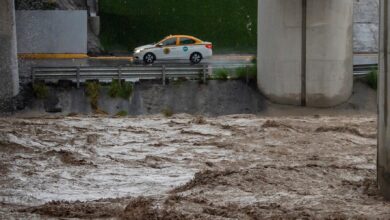The natural disasters of 2020
The beginning of 2020 does not give truce. From major fires to droughts, nature is calling on the human being.

Cars crossing a road in the middle of a flood. / Photo: Pixabay – Reference Image
LatinAmerican Post | Laura Viviana Guevara Muñoz
Listen to this article
Leer en español: Los desastres naturales del 2020
Without a doubt, the beginning of 2020 has been quite moved. From the possibility of a Third World War exploding, to great fires and floods, the world seems to have no rest.
In addition to the climatic effects, product of the consequences of climate change and therefore a proof that this is real, nature seems to give no respite and as if it were revenge, natural disasters are increasingly present. With earthquakes, earthquakes, volcano eruptions, and even droughts, the beginning of the year has not been easy at all.
Earthquakes in Puerto Rico
According to the UN, Latin America and the Caribbean is the second region most prone to natural disasters, which include floods, storms and hurricanes, droughts, high temperatures, volcanic effects and of course, earthquakes.
During the second week of 2020, between January 6 and 7, several earthquakes appeared in Puerto Rico. On the 6th there was a tremor of 5.8 and the next day, two earthquakes of 6.4 and 5.8 shook the south of the island, as reported by the United States Geological Survey.
On Saturday 14 there was also a strong tremor of 4.6 amid the country's recovery from previous earthquakes. According to the governor, Wanda Vázquez, the losses are estimated at around 110 million dollars, a figure that could increase with the continuity of the seismic movements.
Otro temblor de magnitud 4.6 sacudió este martes el área sur de Puerto Rico. El sismo tuvo su epicentro en aguas cercanas a Guánica, Guayanilla y Ponce, informó la Red Sísmica de Puerto Rico. pic.twitter.com/AsCIO5PhCk
— Musavision Canal 10 (@Musavision10) January 14, 2020
According to Prensa Latina, “more than 7,000 people remain in shelters,” another figure that could vary according to recent events, since on January 15, a new earthquake of magnitude 5.2 was presented in Puerto Rico.
According to the Geological Survey of the United States and in information compiled by CNN, “this quake increased the probability of a magnitude 6 replica by 12%, also increased the chances of higher aftershocks by 4% to 6.4”.
In addition, the same institution said that earthquakes are more likely to continue decreasing in the next 30 days, "and that no more earthquakes similar to the 6.4 one on January 7, will occur" according to El Nuevo Día.
Read also: Fires in Australia and floods in Indonesia: this is how 2020 began
The volcanoes wake up
In recent days, attention was focused on the Philippines due to the imminent eruption of the Taal volcano, which has erupted since January 12, when it ejected a cloud of ash and lava in a small magnitude.
Since that day, the volcano has maintained several activities, which has meant the evacuation of 53,019 people. In addition, the Philippine National Disaster Risk Reduction Council reported that evacuees are in 198 evacuation centers designated by the authorities.
The authorities said that the alert level is in 4 of the 5 possible and although a reduction in the smoke column is noted, they are alert to any developments. The above, taking into account the more than 280 volcanic earthquakes, of which around 120 have been perceived. As France24 recalls, the Taal volcano is one of the smallest in the world, but one of the most active, since it has shown signs of activity since 1991.
Aquí puedes ver en vivo la erupción del volcán #Taal, Filipinas
En algunas zonas la acumulación alcanza más de 20 cm de espesor con riesgo de colapso de techos además de riesgos asociados a la salud. El ecosistema local también se ha visto afectado.https://t.co/cF8PRGRvZl pic.twitter.com/VG2rLOYoUS
— SkyAlert (@SkyAlertMx) January 13, 2020
However, the Philippines is not the only place where volcanoes seem to have woken up. Volcanic eruptions occurred both in Alaska and Japan. In Alaska, on January 6, the Shishaldin volcano began its activity by throwing an ash cloud at more than 7,010. Since that time, the Alaska Volcanological Observatory (AVO) has maintained the alertness and observation of this volcano.
View of #Shishaldin #volcano incandescence as seen from Cold Bay, last night (Jan 6), about 58 mi NE of the volcano. Photos courtesy of Aaron Merculief. AVO Shishaldin updates here: https://t.co/cpWlp8NTdS pic.twitter.com/1mYHQltdS6
— Alaska AVO (@alaska_avo) January 7, 2020
On the other hand, in Japan, more specifically on Kuchinoerabu Island in the Satsunan archipelago, the Shindake volcano erupted on January 11. Initially, the authorities did not issue evacuation alerts, cataloging the eruption at a level three of five possible, but finally evacuated the 140 inhabitants who also had to flee from flying rocks and pyroclastic flows (a mixture between volcanic gases, ashes, and rocks), according to Prensa Latina.
気象庁によりますと、11日15時05分に口永良部島(新岳)で噴火が発生し、噴煙は火口縁上2000mで雲に入りました。
口永良部島(新岳)で噴火が発生
気象庁によりますと、11日15時05分に口永良部島(新岳)で噴火 pic.twitter.com/wCUH8nmSHX— 田中なおこ (@Scpnaoko) January 11, 2020
Read also: Madagascar's rainforest habitat is also in danger
From floods to droughts
At the end of 2019, Venice was seen in one of the worst floods. Although the city is accustomed to being surrounded by various channels that reach 150 centimeters high, on November 13, Venice experienced one of the worst floods in its history. That Wednesday the water reached 187 centimeters, a phenomenon that surprised the Italians, who for two months were exposed to the constant growth of the water level.
Well, on January 6 the opposite phenomenon was presented since January is one of the months with less pressure, which means that the level can reach -60 centimeters. However, the figures reached -50 centimeters, something historic for the city.
#datofeo
Es increíble como el mundo da vuelta todo , el mes pasado #venecia sufría la inundación más fuerte de su historia y hoy día tiene una de las sequías más fuertes #cambioclimatico #fridayforfuture pic.twitter.com/dBFlSM8YA1— Lauty (@lautaro_emma) January 10, 2020




